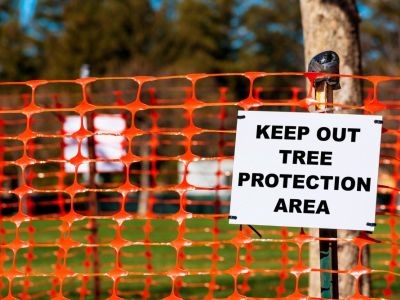Tree Protection during Construction
Did you build your home near mature trees to take advantage of their beauty and aesthetics? You are not alone. Many trees take decades to develop the strong deep roots and attractive canopies they attain at maturity. Unfortunately, the trees you want near your home are at risk during construction. Preventing tree damage in work zones is a matter of planning carefully and working closely with your contractor.
Preventing Tree Damage in Work Zones
Trees are at risk when construction work goes on around them. They can suffer many different types of injury. Use these tips to help prevent this damage.
Trunks and Branches
The equipment used during construction can easily injure a tree’s trunk and branches. It can tear into the bark, snap branches, and open wounds in the trunk, allowing in pests and diseases. You can and should emphasize to the contractor your intention to ensure tree protection during construction. In addition, you’ll need to take action to enforce this mandate. Erect sturdy fencing around each and every tree. Place it as far out from the trunk as possible and tell construction personnel to stay out of the fenced areas and to keep all construction materials out.
Tree Roots
The tree’s roots are also at risk when work includes digging and grading. Roots can extend out three times as many feet as the tree is tall. When construction crews sever a tree’s roots close to the trunk, it can kill the tree. It also limits the tree’s ability to stand upright in winds and storms. Tell your contractor and crew that the fenced areas are out of bounds for digging, trenching, and every other type of soil disturbance.
Soil Compaction
Trees require porous soil for good root development. Ideally, the soil will have at least 50% pore space for air and irrigation. When heavy construction equipment passes over a tree’s root area, it compacts soil dramatically. This means that the root growth becomes inhibited, so water cannot penetrate as easily and the roots get less oxygen. Adding soil may seem less dangerous, but it, too, can be fatal to the tree roots. Since most of the fine roots that absorb water and minerals are near the soil surface, adding a few inches (5 to 7.5 cm.) of soil smothers these important roots. It can also result in the death of larger, deeper roots. The key to protecting tree roots in construction zones is constant vigilance. Make sure the workers know that no additional soil can be added to the fenced areas protecting the trees.
Removing Trees
Protecting trees from construction damage also pertains to tree removal. When one tree is removed from your backyard, the remaining trees suffer. Trees are plants that thrive in a community. Forest trees grow tall and straight, producing high canopies. Trees in a group protect each other from winds and scorching sun. When you isolate a tree by removing neighboring trees, the remaining trees are exposed to the elements. Protecting trees from construction damage includes forbidding the removal of trees without your permission. Plan around existing trees rather than removing any of them when at all possible.
